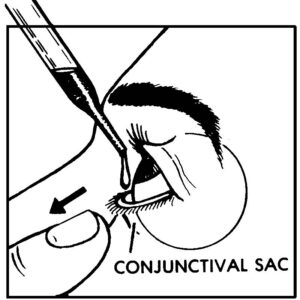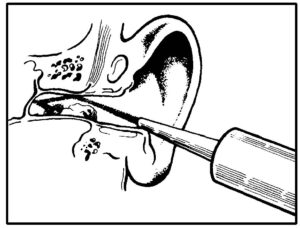1-12. PRECAUTIONS FOR THE EYES
To prevent injury to the eye and to apply the most effective methods of treatment, it is necessary to understand and practice safety precautions.
a. Cleansing the Eyelids. The eyelids are always cleansed prior to the instillation of any medication and the application of compresses and dressings. The eyelids must also be cleansed after the dressings are removed following eye surgery.
(1) The eyelids are cleansed with 2×2-inch gauze squares moistened in sterile normal saline or with a solution prescribed by the physician. With the patient’s eyes closed, wipe gently from the inner canthus (corner) to the outer canthus. Be careful not to exert any pressure on the globe.
(2) Use a fresh piece of gauze for each stroke.
b. Positioning. Proper positioning of the patient prior to giving eye treatments is important to ensure that the head is under control and the eye is properly opened.
(1) When the patient is seated in a chair, the care giver may stand behind the patient to give support to the head.
(2) A patient lying in bed has sufficient support from the bed.
(3) To prevent injury when instilling drops or ointments, brace the hand holding the medication on the patient’s forehead. This prevents your hand from shaking, and allows your hand to move with the patient.
(4) To prevent the spread of infection when irrigating the eye, tilt the patient’s head toward the affected side so that the solution will flow from the inner canthus to the outer canthus. Do not allow the solution to flow across the nose into the unaffected eye. Do not touch the eye with the irrigating equipment.
1-13. INSTILLING EYE DROPS OR OINTMENTS
a. Review the patient’s clinical record to verify the order.
b. Wash your hands and assemble the necessary equipment.
(1) Prescribed medication.
(2) Normal saline solution.
(3) Two by two inch gauze squares.
(4) Tissues.
c. Approach and identify the patient.
d. Explain the procedure and the purpose of the medication to the patient.
e. Provide for privacy, if appropriate.
f. If the patient is wearing an eye dressing, remove it by gently pulling down and away from the forehead. Discard the dressing and wash your hands.
g. Remove any accumulation of discharge by cleansing around the eye. Use the procedure outlined in paragraph 1-12a.
(1) If secretions are crusted, apply a moistened gauze square over the closed eye and leave in place for several minutes.
(2) Reapply as necessary until secretions are soft enough to be removed without traumatizing the mucosa.
h. Position the patient.
(1) Supine in bed is the position of choice.
(2) Seated in a steady chair is acceptable.
i. Prepare the medication.
(1) Remove the cap of the medication container, being careful to avoid contamination of the cap.
(2) If administering drops with a measured dropper, fill the dropper to the prescribed dose. (Many medications come in plastic containers that deliver a set dose per drop when the container is gently squeezed.)
(3) If administering an ointment, squeeze out a small amount onto to a sterile gauze square in order to remove any crust that may have formed. Discard the gauze.
j. Instill the medication.
(1) Steady the hand holding the medication against the patient’s forehead.
(2) Instruct the patient to look up and to the side.
(3) With your free hand, gently pull down the lower lid of the affected eye, exposing the conjunctival sac.
(4) Instill the prescribed amount of drops or a thin ribbon of ointment into the conjunctival sac (figure 1-4). NEVER instill the medication directly onto the eyeball.

k. Instruct the patient to close the eyes gently (without squeezing the lids shut), and roll the eyes. This will distribute the medication.
l. Remove any excess solution or ointment from around the eye by blotting gently with a clean tissue or gauze square.
m. Apply a fresh dressing if required.
n. Provide for the patient’s comfort.
o. Remove supplies from the bedside and store or discard as appropriate.
p. Wash your hands.
q. Record the procedure in the patient’s clinical record.
1-14. IRRIGATING THE EYE
a. Wash your hands and assemble the necessary equipment.
(1) Towel.
(2) Chux pads.
(3) Sterile gauze pads.
(4) Tissues.
(5) Irrigation solution (at room temperature).
(6) Emesis basin.
b. Approach and identify the patient.
c. Explain the procedure to the patient.
d. Assist the patient into the supine position, with the head turned toward the affected side.
e. Place a chux pad under the patient’s head to protect the bed linen. Place an emesis basin against the affected side, next to the cheek, to catch the solution as it runs off.
f. Using the thumb and index finger of your non-dominant hand, separate the patient’s eyelids.
g. Perform a moderate irrigation:
(1) Direct a constant flow of irrigation solution toward the inner canthus of the eye. Administer about one-half of the solution in the bottle. (Bottles of sterile ophthalmic irrigation solution are available for moderate irrigations.)
(2) Inspect the eye for foreign particles.
(3) Attempt to remove particles by touching them gently with a piece of sterile gauze that has been moistened with the solution. The particle should adhere to the gauze.
(4) Continue irrigation until the eye is clean or the prescribed amount of solution has been used.
h. Perform a copious irrigation:
(1) Attach IV tubing to a 1000cc container of sterile normal saline solution.
(2) Open the flow clamp, and direct a stream of fluid toward the inner canthus of the eye. Do not allow the end of the IV tubing to touch the eye.
(3) Periodically stop the flow of solution and inspect for foreign particles. If particles are seen, attempt to remove them in the same manner as described in g.(3) above.
(4) Continue the irrigation until the eye is clean or the prescribed amount of solution has been used.
i. Dry the eyelids by blotting gently from inner to outer corner with gauze squares.
j. Provide for the patient’s comfort.
k. Remove supplies from the bedside and store or discard as appropriate.
l. Wash your hands.
m. Record the procedure in the patient’s clinical record.
1-15. APPLYING EYE DRESSINGS
a. Wash your hands and assemble the necessary equipment.
(1) Sterile eye dressings (gauze squares or pre-cut eye patches).
(2) Hypoallergenic tape.
b. Approach and identify the patient. Explain the procedure.
c. Inspect the eyes for discharge or crusting, and cleanse the eyes.
d. Instruct the patient to close both eyes.
e. Place the patch gently over the affected eye. (If ordered by the physician, place a patch over the other eye as well. The physician will often prescribe a dressing for both eyes in order to help immobilize the affected eye.)
f. If the eye patches are not a self-adherent style, secure the patches in place with several pieces of hypoallergenic tape.
g. Provide for the patient’s comfort and place the call bell within reach.
h. Remove supplies from the bedside and store or discard as appropriate.
i. Record the procedure in the patient’s clinical record.
1-16. INSTILLING EAR DROPS
a. Review the patient’s clinical record to verify the physician’s order.
b. Wash your hands and assemble the necessary equipment.
(1) Prescribed medication.
(2) Cotton balls and gauze squares.
(3) Normal saline solution.
(4) Medicine dropper.
c. Approach and identify the patient.
d. Explain the procedure to the patient. Instruct him that it will be necessary to lie still for 10-15 minutes after the procedure.
e. Place the patient in a supine position with the head turned toward the unaffected side.
f. If necessary, cleanse the external ear with the saline and cotton balls or gauze squares.
g. Remove the cap from the medication container and, if a dropper is to be used, draw up the correct amount of medication. Do not contaminate the container cap.
h. With the non-dominant hand, straighten the external ear canal by gently pulling up and back on the ear for an adult, or down and back for a child.
i. Instill the prescribed amount of medication, one drop at a time.
(1) Direct the flow of the medication toward the roof of the ear canal.
(2) Do not allow the dropper (or the tip of the bottle) to touch the ear.
j. Place a cotton ball loosely into the opening of the ear canal to absorb any excess medication.
k. Instruct the patient to lie still for 10-15 minutes to allow the medication to be absorbed, rather than run out of the ear. (The head should remain turned toward the unaffected side.) After this period, assist the patient to a comfortable position.
l. Remove supplies from the bedside and store or discard as appropriate.
m. Wash your hands.
n. Record the procedure in the patient’s clinical record.
1-17. IRRIGATING THE EAR
a. Review the patient’s clinical record to verify the physician’s order to irrigate the ear.
b. Wash your hands and assemble the necessary equipment.
(1) Ear irrigation syringe.
(2) Irrigating solution.
(3) Cotton balls and gauze squares.
(4) Emesis basin.
(5) Large basin.
(6) Sterile solution thermometer.
(7) Chux pads.
c. Fill the large basin with hot water and place the container of irrigating solution into it.
d. Approach and identify the patient.
e. Explain the procedure to the patient.
f. Clean the external ear with moistened cotton balls or gauze squares.
g. Wash your hands.
h. Test the temperature of the irrigating solution with the sterile solution thermometer. The solution should be between 95ºF-105ºF (body temperature) to avoid causing dizziness.
i. Assist the patient to a sitting position with the head tilted slightly forward and toward the affected side.
j. Place a chux pad over the patient’s shoulders to keep clothing dry.
k. Fill the irrigating syringe with solution and expel all air from the syringe.
l. Instruct the patient to hold the emesis basin against his neck, directly under the ear to be irrigated.
m. Straighten the ear canal.
n. Point the tip of the irrigating syringe upward and toward the back of the ear canal.
o. Direct a steady stream of solution into the ear, aiming toward the roof of the ear canal (figure 1-5).

p. Observe the solution as it returns. Note the presence of cerumen or other matter.
q. Observe the patient for signs of pain, nausea, or dizziness. Stop the irrigation immediately if these symptoms occur. Report to the professional nurse at once. These symptoms could be the result of a disturbance in the middle or inner ear, or may indicate a damaged tympanic membrane.
r. Refill the syringe and repeat the procedure until the return flow of solution is clear, or all of the prescribed solution has been used.
s. Assist the patient to a recumbent position, lying on the affected side for several minutes to facilitate complete drainage of the ear canal.
t. Clean the ear and surrounding skin with moistened cotton balls. Blot dry.
u. Remove supplies from the bedside and store or discard as appropriate.
v. Wash your hands.
w. Record the procedure in the patient’s clinical record.
